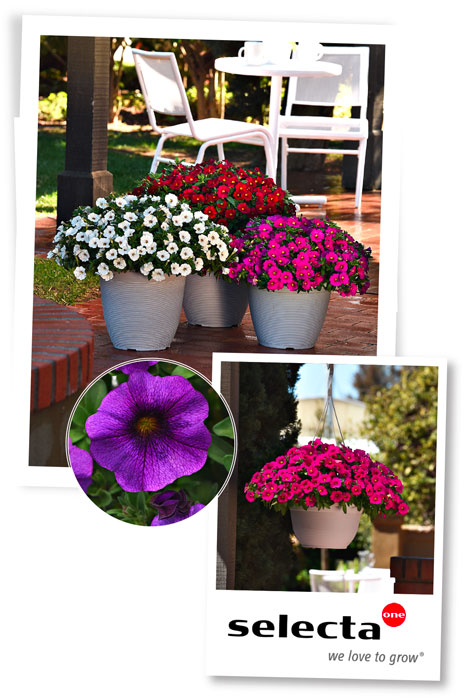7/1/2023
Multi-Season Toughness
Jennifer Polanz

Calibrachoa are the No. 1 selling annual in North America, but most consumers don’t even know them by name – they call them “million bells.” Petunias are also within the Top 3 and are hugely popular, but can be problematic once the heat of summer kicks in.
“Consumers and landscapers recognize both of these flowers and buy them every year. They are both very forgiving for consumers—especially for anyone who doesn’t have a green thumb,” said Selecta One North America Product Manager Becky Lacy. “Even though consumers have
always been satisfied, our plant breeders knew they could improve the weaknesses of each genus and take on the challenge of creating something really extraordinary.”
Enter the class of petchoa (pronounced pet-ko-ah), a genetic cross of petunia and calibrachoa, a class that’s still awaiting official recognition. That challenge was accepted by several breeders, including Anita Stöver, an in-house breeder at one of two Selecta One breeding stations, this one in Stuttgart, Germany (the other is in Latina, Italy). Anita began her crosses in 2018, working to pull out the best of both while leaning a little heavier on the calibrachoa genetics.
Pros and Cons
Before we talk about what Anita came up with, let’s take a quick look at the attributes of petunias and calibrachoas. Becky, the product manager, said petunias tend to do well in cold weather, perform in the landscape and have large flowers. (Bigger is better in the United States.) Calibrachoas are more tolerant of heat and they’re prolific bloomers.
Unfortunately, petunias can struggle in extreme heat, have difficulty bouncing back after a hard rain, and can be a bit messy when large flowers fade and “melt,” requiring deadheading. Petunias have a smaller range of color variations compared with calibrachoa. They also produce sticky cuttings, making them more difficult for workers to separate and release when sticking.
Calibrachoas aren’t as frost tolerant and aren’t typically great landscape plants because they can be susceptible to iron deficiency, according to Becky. And while they’re more floriferous than petunias, they have smaller flowers.
What was needed was a flower with the best qualities of both plants. Thanks to Anita’s breeding, EnViva Petchoa is designed for three-season success.
“EnViva offers all the best attributes of petunias and calibrachoa. They have large, colorful flowers that can be used in the landscape and in container gardening with excellent cold, heat and rainy weather performance,” Becky said, noting that the heavier emphasis on calibrachoa
genetics lends more flower power. “It’s easier to control for the grower, so it usually doesn’t need a pinch and needs less plant growth regulators. And it has better branching.”
Thinking back to this past spring and all the frosts that occurred throughout the country, how important would it be for growers to have a big bloomer that withstood the cooler weather while still performing in the heat, keeping a mounding habit on the retail bench and spreading in the landscape? GP
Fast Facts:
EnViva Petchoa series colors: White, Red, Blue and Pink
Great for: Monoculture containers, components in mixed combos, hanging baskets and individual pots for landscape use
Available: For sample in smaller quantities now, new for retail in spring 2024